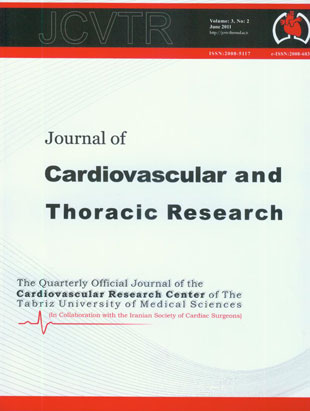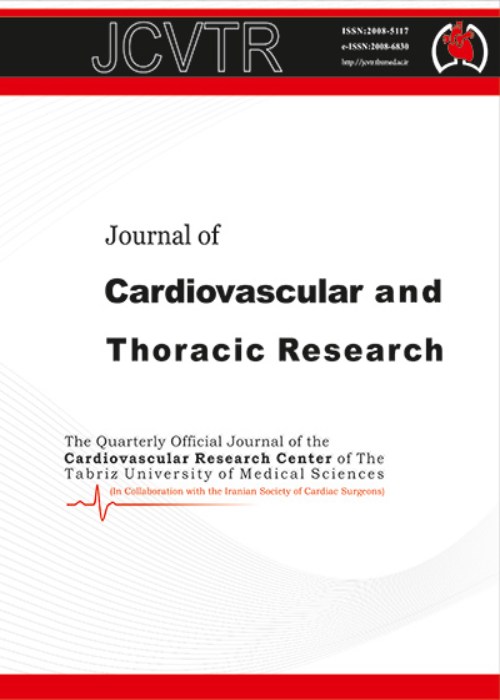فهرست مطالب

Journal of Cardiovascular and Thoracic Research
Volume:3 Issue: 2, May 2011
- تاریخ انتشار: 1391/01/07
- تعداد عناوین: 7
-
-
Page 45Diabetes mellitus is associated with an increased risk of adverse clinical outcomes after percutaneous coronary intervention (PCI). The prognosis of patients with diabetes mellitus and chronic total occlusion (CTO) treated with PCI is poorly investigated. Current study evaluates outcome of successful PCI on CTO in patients with and without diabetes. One hundred and sixty three patients treated with successful PCI on CTO between January 2009 and March 2011 were prospectively identified from the PCI registry at the Madani Heart Center, Tabriz, Iran. Patients were followed for 15±3 months, were evaluated for the occurrence of major adverse cardiac events (MACE) comprising death, acute myocardial infarction, and need for repeat revascularization. No differences were found in baseline clinical and procedural variables between patients with (n=34) and without diabetes (n=129), unless for hypertension (p=0.03). Hospitalization period after PCI in diabetics (3.26±0.61 days) and non-diabetics (2.86±0.52 days) was similar. In-hospital MACE occurred in 8 (23.5%) individuals of diabetics and 10 (7.8%) individuals of non-diabetics (p=0.02), among them revascularization was significantly higher in diabetics (20.6% vs. 7%, p=0.04). Follow-up events in diabetic and non-diabetic groups were 12 (35.3%) and 37 (28.5%), respectively (p was not significant). In patients undergoing successful PCI on CTO, diabetes is associated with higher in-hospital adverse events; however diabetes does not affect long term outcomes in these patients.
-
Page 49Enhanced external counterpulsation (EECP) is a noninvasive circulatory assist device that has been recently emerged as a treatment option for refractory angina or left ventricular (LV) dysfunction. The aims of this study were to examine the effects of EECP on the elecrocardiographic parameters and the heart rate variability indices of patients with the coronary heart disease and function class II-III angina resistant to medication. In a descriptive study, the patients who presented with sever angina at function class II-III were studied. Those meeting the inclusion criteria were invited to participate and provided informed consent. The standard enhanced external counterpulsation treatment (35 one-hour procedures 5-6 times a week) was done. Thirty minute ambulatory electrocardiographic monitoring and electrocardiogram before starting and at the end of treatment sessions were done. Data entry and analysis of data was done finally. Twenty five patients with mean age 68±9 year including 21(84%) men and 4(16%) women were enrolled in this study. Electocardiogarphic parameters before and after treatment by EECP were not different statistically. Time domain indices of heart rate variability according to ambulatory monitoring findings were not changed significantly. Results of this study revealed that EECP didn’t improve the electrocardiographic and heart rate variability parameters of ischemic heart disease patients with refractory angina at function class II or III.
-
Page 53Renal failure predisposes patients to adverse outcome after coronary artery bypass grafting (CABG). Renal dysfunction is a predictor of increased morbidity and mortality after CABG, whether it is dialysis-dependent or not. In a retrospective study from April 2000 to December 2010, seventy-six patients (60 male and 16 female with the mean age of 58.57±7.93 years) with different categories of chronic renal failure undergoing CABG in Shahid Madani Hospital, were studied. The cardiac disease leading to the operation was coronary artery disease (CAD) in all patients. Patients demographic, surgical and laboratory data were gathered from hospital records. Data were then analyzed. Mean hospital stay was 10.16±7.16 days. The preoperative mortality rate was 10.5% (15% in non dialysis and 5.6% in dialysis dependant patients with no significant difference). Morbidity rate was 28.9% (respectively 30% and 27.8% in dialysis and non dialysis patients with no significant difference) including in-hospital myocardial infarction (MI) (10.5%), in-hospital stroke (2.6%), in-hospital bleeding (21.1%) and in-hospital infection, pneumonia, (5.3%). Mean creatinine and blood urea nitrogen (BUN) levels were significantly increased after surgery (p<0.001). Postoperative hemodialysis rate was 33.3%. Chronic renal failure whether dialysis-dependant or not increases in-hospital mortality and morbidity in patients undergoing CABG. For CRF patients not on dialysis with a creatinine 2.5 gm/dL, there is a strong likelihood of postoperative dialysis.
-
Page 57Most studies reported using N-terminal pro-brain natriuretic peptide (NT-proBNP) in diagnosis of heart failure but there is controversy about use of these tests in determining prognosis and classification of severity of heart failure. The objective of this study was to determine the value of plasma NT-proBNP levels assessment in evaluation of mortality and morbidity of patients with systolic left ventricular dysfunction. A cohort study was performed in 150 patients with heart failure since September 2009 until February 2010. The patients were followed for 6 months to assess their prognosis. Patients were divided into two good and bad prognosis groups according to severity of heart failure in New York Heart Association (NYHA) class and frequency of hospital admission and mortality due to cardiac causes. Patients with good prognosis had ≥1 admission or no mortality or NYHA class≥2 and patients that had one of this criteria considered as bad prognosis groups. Pro-BNP levels were measured at baseline and left ventricular ejection fraction (LVEF) was estimated with echocardiography. Data was analyzed with using Chi-square, t-test, ANOVA, Kruskal-Wallis tests. In patients with heart failure that enrolled in this clinical study, ten patients were lost during follow-up. The mean of NT-proBNP is significantly correlated with ejection fraction (p=0. 003) and NYHA class (p<0/001). In our study among 140 patients who were follow-up for 6 months, 11(9. 7%) of individuals died with mean NT-proBNP of 8994. 8±8375 pg/ml, in survived patients mean NT-proBNP was 3756. 8±5645. 6 pg/ml that was statistically significant (P=0. 02). Mean NT-proBNP in the group with good prognosis was 2723. 8±4845. 2 pg/ml and in the group with bad prognosis was 5420. 3±6681 pg/ml, difference was statistically significant (P=0. 0001). Our study in consistent with other studies confirms that NT-proBNP is significantly correlated with mortality and morbidity. This could be predicting adverse out come and stratification in patients with heart failure. It is recommended that more research be performed in Iran.
-
Page 63The idea which the progression of coronary artery disease is regularly reversible was previously radical concept but today it has become the most common. A number of interventions have been reported to arrest or reverse the progression of coronary atherosclerosis, many of which have been detailed in the time those include comprehensive changes in lifestyle.5 A total of 100 patients aged less than 65 years were interrogated, 50 patients in case groups and 50 in control groups. All severely ill patients, and patients aged more than 65 years were excluded. We used educational packages for all of our patients, to teach all of them risk factors for coronary heart disease (CHD) and how to change their lifestyle to reduce those risk factors. Data were analyzed by SPSS software. Patients in intervention group significantly reduce the intake of saturated fat, sugar, and cholesterol (p<0/001), increased their exercises (p<0/001), and stopped smoking (p<0/05), when compared with the usual case group. This study demonstrated that education has a very important role in changing lifestyles of CHD patents and it helped to reduce risk factors of CHD.
-
Page 67The patient was 35-year-old women with a six month history of difficulty breathing and chest pain. An anterior-posterior chest radiograph revealed a widened mediastinum with small lung volumes. During his diagnostic evaluation, a computed tomographic scan was performed and with huge mass in the anterior mediastinum with extension to the left and right side of pleural space. With postero-lateral thoracotomy the huge mass was resected. The patient discharged with good condition.
-
Page 71A 20-year old female with a rare anomaly of aortocaval tunnel to superior vena cava is presented. Rare cases of congenital communications between aorta and right sided of the heart has been reported previously. The patient underwent surgical repair and had uneventful recovery.


